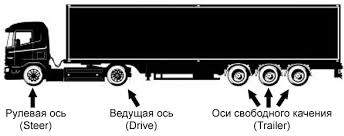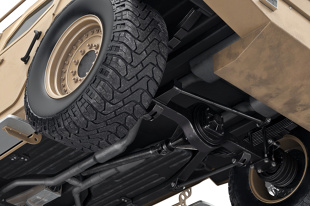
Leading axle. What do you need to remember?
 The design of the drive axle is precisely adapted to the type of vehicle. The role of the bridge is to constantly transmit torque to the wheels. It also turns its course at the right angle - most often at a right angle.
The design of the drive axle is precisely adapted to the type of vehicle. The role of the bridge is to constantly transmit torque to the wheels. It also turns its course at the right angle - most often at a right angle.
The bridge changes the magnitude of the moment, the speed of rotation, allows you to install road wheels, as well as elements of the brake system and transfer vertical forces arising from the weight of the vehicle and cargo, as well as lateral and longitudinal forces. as well as torque.
Leading axle. Execution
 Classic drive axles are found in trucks, minibuses, buses, and sometimes in passenger cars with rear-wheel drive and dependent wheel suspension. The rigid scabbard is the heart of the design, as it contains most of the mechanisms. The scabbard must be extremely strong and have as little dead weight as possible.
Classic drive axles are found in trucks, minibuses, buses, and sometimes in passenger cars with rear-wheel drive and dependent wheel suspension. The rigid scabbard is the heart of the design, as it contains most of the mechanisms. The scabbard must be extremely strong and have as little dead weight as possible.
In trucks with a lower gross weight, the scabbard is processed in the form of stamped parts - they are welded together.
The technology makes it possible to produce a scabbard in the form of a drawn element from a seamless pipe or sheet metal. Then the hub seats or axle bearing seats are precisely welded. The seat of the main gear and differential is fixed in the central part with screws. They are made of gray cast iron and their processing is a strictly mechanical process. The opposite opening in the central part of the vagina is protected by a (spherical) sheet metal cover, which is provided with a hole to check the condition of the oil.
Loads are higher in large trucks because they are often used to transport multi-ton loads. In such vehicles, bridges with sheaths are used, made as cast iron, or as rigid structures - welded from thick sheets. Hub bearing journals can be either welded or bolted.
 The drive axle is designed to lower the vehicle's center of gravity. An example of such a solution is a portal bridge. Its characteristic feature is a torn vagina. In the central part, the main gear and differential are asymmetrically located, as well as two cardan shafts of unequal length. Additional housings are screwed to the element on both sides, containing cylindrical side gears, i.e. reducers. The vagina of the bridge is made by casting, which ensures its strength. Portal bridges are widely used in low-floor public transport buses as well as double-decker buses.
The drive axle is designed to lower the vehicle's center of gravity. An example of such a solution is a portal bridge. Its characteristic feature is a torn vagina. In the central part, the main gear and differential are asymmetrically located, as well as two cardan shafts of unequal length. Additional housings are screwed to the element on both sides, containing cylindrical side gears, i.e. reducers. The vagina of the bridge is made by casting, which ensures its strength. Portal bridges are widely used in low-floor public transport buses as well as double-decker buses.
When a given vehicle has a very large carrying capacity, two or even three drive axles (tandem and tridem) are used. Outwardly, they are similar to conventional two-wheel drive vehicle drive axles. The difference lies in how the final drive input shaft is routed. In this case, a sequential axle drive is used, which makes it possible to exclude a transfer case from the drive system.
For example, in a tandem configuration, there is no drive axle. 1 allows you to connect the drive to axle No. 2. XNUMX, and to prevent tensions between the axles resulting from an instantaneous difference in wheel speed, the system is equipped with a differential (interaxle).
See also: When can I order an additional license plate?
Trucks traveling over rough terrain use rear-wheel drive and one or two steered axles. In this regard, the drive axles must be equipped with elements of the steering system. The sheath of the bridge has heads on both sides, which allows you to rotate the mount of the steering knuckle, the one that is driven. The steering knuckle pins can be mounted on guides or on rolling bearings. The shape of the bridge sheath head ensures the tightness of the connection and protection of the drive shaft hinge.
Driving axle in passenger cars
 The bridges described earlier are referred to as unsprung masses. The more unsprung weight, the less driving comfort. Therefore, this type of bridges is practically not used in passenger cars - although there are exceptions.
The bridges described earlier are referred to as unsprung masses. The more unsprung weight, the less driving comfort. Therefore, this type of bridges is practically not used in passenger cars - although there are exceptions.
In an effort to increase the disproportion between sprung and unsprung masses, the engineers developed a solution based on the introduction of a residual housing containing the final drive and differential. The structure is attached to the body or subframe, while moving to the sprung mass. Thus, the torque is transmitted to the wheels by means of single or double jointed cardan shafts. In addition, the possibility of rear-wheel drive is retained - with the engine installed in front of the car.
In vehicles with a lockable drive system (in which the drive is part of the unsprung mass), the internal elements of the axle are located in a common housing with the gearbox. In the case of rear-wheel drive and front-wheel drive, the body is made of aluminum alloys, as it is not affected by the weight of the car and the load.
Leading axle. Operation and repair
If you want to enjoy the trouble-free operation of the described element, first of all, you should remember to change the oil regularly, in accordance with the manufacturer's recommendations. It is also worth regularly checking its level and tightness of the joints, because the seals can deteriorate over time. The parameters of the oil used are specified by the vehicle manufacturer. You can find them in the car's owner's manual, on the manufacturer's websites, or on the brand's forums. The replacement process is relatively simple, unscrew the drain plug, drain the used oil, install a new plug and fill the system with fresh oil. Take a test drive after work. When a bridge makes a lot of noise, this is a sign that it has been significantly worked out and should be handed over to a specialist as soon as possible.
See also: What you need to know about the battery
